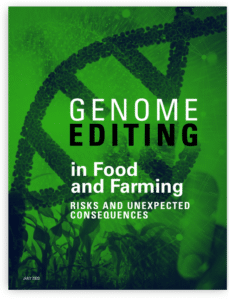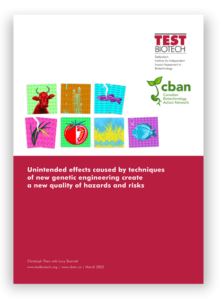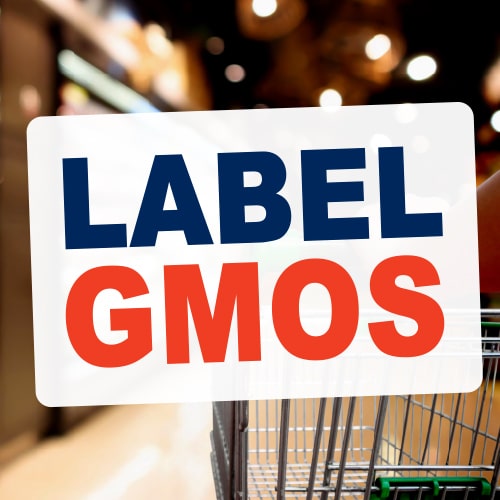Désolé, la version française de cette page ne peut être offerte pour le moment.
Genome Editing
Genome editing, also called gene editing, techniques are a type of genetic engineering, resulting in the creation of genetically modified organisms (GMOs). Genome editing is a collection of techniques that alter the genetic material of plants, animals and microbes. The aim is to insert, delete or otherwise change a DNA sequence at a specific, targeted site or sites in the genome. These new genetic engineering (genetic modification or GM) techniques raise many of the same risk questions as earlier techniques of genetic engineering, and raise the same environmental, social, economic and ethical concerns.
The new techniques can make it easier and faster to genetically engineer a wider range of organisms, for more purposes. They are powerful research tools that are being used to better understand gene function and, in particular, to genetically modify mice and other research animals to study human diseases. They are also being used to experiment with creating new GM crop plants and farm animals. The biotechnology industry argues that genome editing should not be classified as genetic modification, and should not be regulated or labelled.
CBAN Briefing: Gene editing is new genetic engineering. August 2025
CBAN Factsheet: Introduction to Genome Editing, July 2020
CBAN Report: Genome Editing in Food and Farming: Risks and Unexpected Consequences, July 2020
Updates
June 2025: New research finds that, globally, only three gene-edited GMOs are currently being cultivated: two gene-edited transgenic corn plants grown in the US (insect- and herbicide-resistant) and a gene-edited tomato (with increased GABA content intended to lower blood pressure) cultivated in Japan. At least 49 gene-edited crops are currently in development. Two of the earliest gene-edited crops released have already been withdrawn due to commercial failure. New GMOs Market Report, European Non-GMO Industry Association (ENGA) and the Non-GMO Project, June 10, 2025
July 2024: A new study shows that the use of CRISPR/Cas ‘gene scissors’ causes unintended genetic changes that are different from random mutations. Major structural changes in chromosomes occur much more frequently in the genomic regions targeted by the ‘gene scissors’ than would otherwise be the case. See Lazar, N.H., Celik, S., Chen, L. et al. High-resolution genome-wide mapping of chromosome-arm-scale truncations induced by CRISPR–Cas9 editing. Nat Genet 56, 1482–1493 (2024) https://doi.org/10.1038/s41588-024-01758-y or the discussion from Testbiotech.
February 2024: The Federal Agency for Nature Conservation of the German government released a briefing that argues against European Union proposals to exempt new genetic techniques (NGTs) from GMO regulation: « It is impossible to exclude potential risks of NGT plants just from the size and number of changes of the DNA sequence. Even small changes by genetic engineering can have a high-risk potential for the environment and health. NGT plants can have potential risks comparable to other genetic engineering techniques and can change plants in ways that go beyond conventional breeding. » Click here to read the briefing
March 2023: Gene editing for sustainable agriculture? CBAN’s comments on the federal government’s proposed Sustainable Agriculture Strategy.
January 2023: The European Network of Scientists for Social and Environmental Responsibility (ENSSER) has released a position statement on the CRISPR/Cas gene editing technique in agriculture and horticulture: « CRISPR/Cas is simply a method of targeting a genetic modification (disruption of a gene, alteration of a gene’s protein coding sequence or insertion of a gene or other genetic element) to a predetermined location in the genome. There is no evidence that crops and livestock animals developed using CRISPR/Cas and other gene editing techniques will fulfil the promises being made for them. On the contrary, they pose risks that must be acknowledged, studied, and controlled through robust regulation. »
May 18, 2022 – Press Release: Federal government abandons safety assessments and transparency for new gene-edited foods
For more background and updates on changes to the regulation of gene edited foods and seeds in Canada see www.cban.ca/NoExemptions
 CBAN/Testbiotech Report, March 2022 – Unintended effects caused by techniques of new genetic engineering create a new quality of hazards and risks, March 24, 2022. A report from Testbiotech (Germany) and the Canadian Biotechnology Action Network (CBAN) discusses the scientific literature that shows the basic differences between plant breeding and genetic engineering, and argues that these differences need to be considered in regulation.
CBAN/Testbiotech Report, March 2022 – Unintended effects caused by techniques of new genetic engineering create a new quality of hazards and risks, March 24, 2022. A report from Testbiotech (Germany) and the Canadian Biotechnology Action Network (CBAN) discusses the scientific literature that shows the basic differences between plant breeding and genetic engineering, and argues that these differences need to be considered in regulation.
CBAN Factsheet, March 2022 – Patents on Genome Editing in Canada, March 3, 2022
September 2020: The first-ever public detection method for a gene-edited crop has been developed by a group of non-governmental organisations, non-GMO food associations and a food retailer. The new research refutes claims by the biotech industry and some regulators that new genetically modified (GM) crops engineered through gene editing are indistinguishable from similar, non-GM crops and therefore cannot be regulated. Click here to read about what this means, or watch the video.
August 2020: A new scientific paper published in the journal Environmental Sciences Europe finds that the risks associated with genome editing include a wide range of unintended effects that can be triggered by the genome editing process, as well as its intended biological characteristics, irrespective of whether additional genes are introduced into the genome or not. The paper concludes that « genetic errors, caused by the genome editing process, have potential implications for food, animal feed and environmental safety. »
July 2020: Use of CRISPR by a team at the University of California Davis has resulted in genetic « chaos » in a gene-edited calf, part of an effort to create single-sex species for agriculture (all male calves for the beef industry). Cuts were made to DNA in unintended places and extra unintended DNA was inserted (from the plasmid). A Crispr calf is born. It’s definitely a boy, WIRED, July 24.
June 2020: A suite of new studies has found large, unwanted changes to the genome at or near the target site (on-target effects). See CRISPR gene editing in human embryos wreaks chromosomal mayhem: Three studies showing large DNA deletions and reshuffling heighten safety concerns about heritable genome editing, Heidi Ledford, June 25, 2020, Nature (news) 583: 17-18.
June 2020: CBAN’s Letter to the Editor, « Non-GMO claims cause confusion » in The Western Producer, in response to the article « Transgenic crops: end of an era, » (June 4).
Introduction
Genome editing, also called gene editing, is a term used to describe a collection of new techniques that alter the genetic material (usually DNA) of plants, animals and microbes. In general, these techniques consist of different types of DNA “editing” systems that aim to insert, delete or otherwise change a DNA sequence at specific, targeted sites in the genome. The organism’s genetic material is changed, not through the breeding process, but directly and artificially by humans, making these techniques a type of genetic engineering, resulting in the creation of genetically modified organisms (GMOs).
Genome editing systems are comprised of molecular components that are programmed to make changes (perform “edits”) at a target location in the genome. The most frequently used genome editing technique is CRISPR-Cas9 or CRISPR, but other techniques follow similar principles.
Claims that these technologies are safer than other GM techniques are unproven. Each gene editing technique brings their own set of risks and uncertainties. Whilst many of these are the same as with older genetic engineering techniques, there are also serious additional concerns. There is a strong scientific case for classifying all these techniques as genetic engineering (genetic modification or GM) and regulating their use with as much rigour as previous and current GM techniques.
The term “editing” implies a level of precision that is not currently, and may never be possible. It suggests the ability to rewrite the genetic code and to simply cut and paste DNA but, in reality, the results are still determined by processes in the organism that we neither fully understand nor control.
Gene editing can more efficiently target sites in the genome but the enzymes used in gene editing have been shown to cut DNA in the wrong spots and create off-target mutations. After a cut is made, the cell’s DNA repair mechanisms are in control of what happens next for the organism. The results can be alterations – such as deletions, insertions, and rearrangements – at the intended site, but also at unintended, off-target sites.
Precise edits, even if possible, do not necessarily yield precise outcomes. Even a simple genetic “tweak” can have wide-ranging effects on an organism’s genome.
« In general, greater precision at the molecular level does not directly result in greater safety or higher success rates in plant development. » – Testbiotech (2020), Overview of genome editing applications using SDN-1 and SDN-2 in regard to EU regulatory issues
CBAN Factsheet: Introduction to Genome Editing, July 2020
CBAN Report: Genome Editing in Food and Farming: Risks and Unexpected Consequences, July 2020
The German group Project Genetic Engineering and the Environment (Fachstelle Gentechnik und Umwelt, FGU), offers four explainer videos with background documents, 2021.
Watch the class Gene Editing: The Science Explained by Dr Ricarda Steinbrecher, Feb 14, 2022, hosted by NFUniversity, National Farmers Union.
Unexpected effects
Any attempt to engineer genomes with such invasive methods can cause unexpected and unpredictable effects. Genome editing can cause genetic errors, including “off-target” effects in the genome, unintended “on-target” effects, interference with gene regulation, and intended and unintended insertion of DNA. These genetic errors are important because they can lead to unexpected and unpredictable effects in the resultant genome-edited organisms, that could be important for food and environmental safety.
Unexpected large deletions or rearrangements of DNA can take place at the intended editing site or elsewhere, and can disrupt the function of non-target genes. Unwanted changes may slip by undetected. Even the intended alteration can inadvertently alter other important genes, causing changes in chemistry or protein production that can be important for food and environmental safety. Genome editing may also have unintended impacts on an organism’s ability to express or suppress other genes. The orchestration of gene function in an organism is part of a complex regulatory network that is poorly understood.
For an overview of the genetic errors that can be caused by genome editing processes, see CBAN’s report Genome Editing in Food and Farming: Risks and Unexpected Consequences, July 2020.
- A continued discussion of the scientific literature is in the CBAN/Testbiotech Report, March 2022 – Unintended effects caused by techniques of new genetic engineering create a new quality of hazards and risks.
March 2021: A new study shows genome editing (also called gene editing) causes drastic unwanted effects in plants including severe deformities, even when the changes are intended to be small « tweaks », such as gene knockouts in existing genes. Kawall, K. Genome-edited Camelina sativa with a unique fatty acid content and its potential impact on ecosystems. Environ Sci Eur 33, 38 (2021).
Case Study: Genome-Edited Hornless Cows
In 2020, scientists at the US Food and Drug Administration (FDA) reported errors in the genome of cows that were genetically engineered to not grow horns. The genome edited hornless cows had been held up as a positive example of the power and ease of genome editing, and discussed as a demonstration of why genome-edited animals do not need to be regulated. However, the case of the hornless cows shows the potential for errors in the genome editing process, and the need for independent safety assessment.
The dairy cows were genome-edited to be hornless (polled), to eliminate the practice of manually dehorning cows. Two cows were developed by university researchers in collaboration with the U.S. company Recombinetics. The developers reported that they were created without foreign genes and “our animals are free of off-target effects”. However, in 2019, researchers at the U.S. Food and Drug Administration (FDA) found unexpected foreign DNA in the cows (on-target effects).
Read the full story (page 12-13) in CBAN’s new report: Genome Editing in Food and Farming: Risks and Unexpected Consequences.
- Read the paper Template plasmid integration in germline genome-edited cattle,
- « No matter how « precise » the initial gene-editing event is in terms of location, undesirable outcomes can occur at the intended site stemming from the DNA repair processes that follow the cutting of the DNA by the editing tool. The findings described in the paper by the US FDA scientists are yet another illustration that looking only for off-target effects from a gene-editing procedure is not enough to identify the full spectrum of undesirable outcomes, which can occur even at the intended gene-editing site. » – from Gene-edited hornless cattle: Flaws in the genome overlooked, GMWatch, August 9, 2019.
- « ...the new FDA finding demonstrates is that the Recombinetics gene-edited cattle do contain DNA unnatural to cattle, despite the claims of their developers to the contrary. Thus FDA does have the authority to regulate. » – from FDA Finds Unexpected Antibiotic Resistance Genes in ‘Gene-Edited’ Dehorned Cattle Independent Science News, August 12, 2019.
- Background on the company Recombinetics from Testbiotech.
Regulation
Some genetically modified organisms (GMOs) produced through techniques of genome editing (gene editing) can enter the market without being assessed for safety by government regulators. They can also enter the market without any notification to the federal government.
There is no pre-market regulation for most gene-edited seeds as well as the foods derived from these genetically engineered (genetically modified or GM) plants. This means that some of these new genetically modified organisms (GMOs) can enter the market without being assessed for safety by government regulators. Instead, product developers can assess the food and environmental safety of their own gene-edited GMOs without government oversight, and without providing any notification to the government or public about their market release. The regulatory exclusion of many gene-edited products enhances safety concerns and comes at the expense of transparency and choice for Canadian farmers and consumers.
In 2022/2023, Health Canada and the Canadian Food Inspection Agency (CFIA) updated regulatory guidance on genetically engineered foods and seeds to exclude genetically engineered plants if they have no foreign DNA. These exemptions will apply to most (but not all) GMOs created with the new genetic engineering techniques of gene editing. Plants that have no foreign DNA and the foods from those plants do not trigger the Novel Food Regulations or Part V of the Seeds Regulations:
- Most gene-edited plants, and the foods from those plants, are exempt from pre-market regulation such that there are no government safety assessments for human consumption or for environmental release. The federal government has handed safety assessments for these plants and foods over to product developers, with no government oversight.
- Additionally, the federal government is not requiring product developers to notify the government when they are releasing unregulated gene-edited foods and seeds onto the market. Instead, the government is “encouraging” companies to let the government know if they are selling new gene-edited foods and seeds. The federal government calls this “voluntary transparency”.
Australia and New Zealand, Argentina, Brazil, Chile and Japan are excluding some genome edited products from risk assessment. European regulations are under debate: In July 2018, the European Court of Justice ruled that genome-edited organisms (obtained by directed mutagenesis techniques) are genetically modified organisms (GMOs) and therefore subject to existing EU GMO regulations.
- Products of new genetic modification techniques should be strictly regulated as GMOs, The European Network of Scientists for Social and Environmental Responsibility, September 27, 2019.
- Gelinsky, Eva, and Angelika Hilbeck. “European Court of Justice ruling regarding new genetic engineering methods scientifically justified: a commentary on the biased reporting about the recent ruling.” Environmental sciences Europe vol. 30,1 (2018). « Regulation is being portrayed as a ban on research and use, which is factually incorrect »
Products
- October 2025: CBAN’s research finds no gene-edited products on the market in Canada but warns that gene-edited mustard greens for salad mixes and gene-edited whole strawberries could soon be the first of the new, unregulated GMOs to enter the Canadian market. See Gene-Edited Fruits and Vegetables: The Threat of New GMOs in Canada, CBAN, October 1, 2025.
- June 2025: CBAN reported that the market release of gene-edited salad greens in Canada and the United States was delayed. See No GMO Salad Update and Action Report, June 2025.
- June 2025: There are only three gene-edited products are currently in cultivation globally: two corn plants grown in the USA which are insect- and herbicide-tolerant, and a tomato with increased GABA content intended to lower blood pressure, cultivated in Japan. See the details in the New GMOs Market Report, European Non-GMO Industry Association (ENGA) and the Non-GMO Project, June 2025.
GM High-Oleic Soybeans, Calyxt, US
The US “plant-based synthetic biotechnology company” called Calyxt has commercialized a high oleic soy (free of trans fats) produced via the genome editing technique of TALENs. It is currently sold in the US only where it was approved in 2015. The high-oleic/low saturated fat oil from this new variety of soybean, with a high-oleic acid content, is designed to eliminate the need for hydrogenation, a process that improves heat stability and shelf life of conventional soybean oil. The process of hydrogenation contributes to the production of trans-fatty acids, which, when consumed, raises low-density lipoprotein, or LDL, cholesterol levels and contributes to cardiovascular diseases. In 2021, Calyxt entered into a seed distribution agreement with Perdue AgriBusiness to contract with growers for grain production and processing under an identity preservation process. This was previously done by Calyxt from 2017 to 2020.
Market Status: The Calyxt soy is grown in the US under identity preserved systems.
GM Herbicide Tolerant Canola, Cibus, North America
Update – 2020: The company Cibus has changed its description of its canola and no longer says it is the product of gene editing (via the technique of oligonucleotide-directed mutagenesis). In 2020, the Canadian Food Inspection Agency (CFIA) changed its 2013 summary of approval (“Decision Document”) that described how Cibus created its canola because it was notified by the company that the description was incorrect. In a letter to CBAN, the CFIA said: “The CFIA was notified by Cibus that the text could be erroneously misinterpreted to mean that Cibus canola event 5715 was developed as a direct result of an oligonucleotide-directed mutagenesis approach known as the Rapid Trait Development System™ (RTDS™). The description now correctly states that this canola was selected during the tissue culture process.” Click here to read the letter from CBAN to the CFIA, December 16, 2020 See below for details.
Market Status: Cibus’ herbicide-tolerant canola was noted as the first genome-edited crop sold in Canada and the US. There are two Cibus canola varieties on the market in Canada, sold in Manitoba and Saskatchewan, under the seed brand Falco™ and was introduced in the U.S. in 2016, and in Canada in 2018. Cibus is a US-based company that is now owned by Farmer Business Network (FNB).
GM High-GABA Tomato, Sanatach Seeds, Japan
This tomato is being called world’s first direct consumption genome-edited tomato. The GM tomato created via the use of CRISPR-Cas9 contains higher levels of gamma-aminobutyric acid (GABA), an amino acid believed to aid relaxation and help lower blood pressure. It is a Sicilian Rouge variety and will be sold by Pioneer EcoScience in Japan. « Sicilian Rouge is a popular tomato, and consumers are already used to buying other products with a high GABA content so we felt it was important to introduce them to the technology in a way that was already familiar to them, » – Shimpei Takeshita, President of Sanatech Seed and Chief Innovation Officer of Pioneer EcoScience
Market Status: Sanatech Seeds has introduced the GM tomatoes through the home gardening channel. “The seedlings will be distributed free of charge to home gardeners and if people like the product they will hopefully share their experience and help spread the word…We opened up a campaign via our website inviting people to join and so far we’ve had 5,000 applicants, each of whom will be given five seedlings to plant. We’re in no rush to introduce the tomato commercially, the important thing is to win over the consumer.” – Shimpei Takeshita, President of Sanatech Seed and Chief Innovation Officer of Pioneer EcoScience
GM Tiger Puffer Fish and Sea Bream, Japan
Two genome edited fish (via CRISPR) were approved for sale in Japan in 2022. The GM fish were developed by Regional Fish Co Ltd. with Kyoto University and Kinki University.
- The genome edited tiger puffer “22-seiki fugu” had its leptin receptor gene disrupted, resulting in increased appetite and rapid weight gain.
- The genome edited red sea bream “Madai” has been genetically engineered to have more meat: CRISPR was used to knock out a protein that suppresses muscle growth.
Market Status: The GM fish are on sale in Japan in limited quantities and are being given away in Japan as a gift to certain taxpayers.
GM Waxy Corn, Corteva, North America and Latin America
The large seed and pesticide company Corteva Agriscience (formerly DowDupont) has clearance – in Canada and the US, as well as in Argentina, Brazil and Chile – to introduce a genetically engineered (genetically modified or GM) corn (maize) produced through CRISPR-Cas9. The company refers to it as “CRISPR-Cas waxy corn” or “Next Gen waxy”. Waxy corn has a different starch profile from other corn. In Corteva’s initial target markets of North America and Latin America, waxy corn is currently a minor crop used for food starch and some industrial products. However, waxy corn, also known as sticky or glutinous corn, is a major food crop in East and Southeast Asia, where it originates. This is the first GM waxy corn. Corteva is using its GM waxy corn to test out the regulation of, and public response to, the new genetic engineering technique of CRISPR. In February 2020, Health Canada determined that Corteva’s GM waxy corn was “non-novel” and did not therefore need to undergo a government safety assessment,: this product “is equivalent to varieties that have a history of safe use as food”. This decision was made public in September 2020.
Market Status: The market status of this GM waxy corn is unknown.
- « Product Profile – GM Waxy Corn: Corteva« , CBAN, March 2021.
- « GM waxy maize: The gene edited Trojan Horse is moving through the gates« , GRAIN, March 2021.
Detection
Studies show that detection and identification of gene-edited (new genomic techniques/NGT) plants will be possible, as long as such research continues to be supported.
August 2025: The EU-funded DARWIN project has published its first scientific paper offering a proof of concept for detection on gene-edited organisms, within the scope of the project. Their policy briefing concludes that detection methods for products are feasible, especially when developers provide the necessary genetic data, as currently required under the current EU legislation (Directive 2001/18/EC and Regulations 1829/2003 and 1830/2003), and that mandating that developers disclose a minimum level of genetic information would significantly reduce the cost and complexity of detection for enforcement authorities and food and feed operators. This would also accelerate the development of robust, science-based monitoring systems.
The work focuses on the analytical detection of products derived from gene-editing technologies such as TALENs and CRISPR/Cas and reaffirms that PCR-based methods (qPCR, dPCR) remain highly effective for detecting genetically modified organisms (GMOs) and can be adapted to detect new genomic techniques (NGTs) when prior knowledge of the modification exists.
DARWIN researchers have also demonstrated the effectiveness of combining whole genome sequencing, public genome databases, and machine learning to identify a minimal set of unique genetic markers or “genetic fingerprint”. This fingerprint enables the unambiguous identification of an NGT line. Importantly, this fingerprint can be detected using both untargeted and semi-targeted analytical approaches, showing strong potential for the identification of NGT modifications. While these methods are not yet implemented in official GMO control frameworks and therefore require further development and validation, the approach represents a significant step toward ensuring the reliable detection and traceability of gene-edited organisms. Read the DARWIN press release, August 19, 2025.
September 2024: A study commissioned by the German Federal Office for Agriculture and Food has shown that detection and identification of new GMO (new genomic techniques, NGT) plants will be possible, as long as such research continues to be supported. The study succeeded in developing two analytical methods for detecting previously known mutations in NGT lines in the barley and oilseed rape lines analysed. These methods reliably detected the introduced mutations, even in seed mixtures containing quantities of only 0.9% and 0.1%. They also confirmed indications of an analytical approach that could – in certain cases – be used to identify genome-edited lines as such, i.e. to distinguish them from a conventional line with the same mutation. The accredited reference laboratories involved in the project optimized the methods and successfully tested them for specificity, selectivity and applicability. The study shows that the genetic change to be looked for must be precisely documented and known. To ensure this, companies wishing to market NGT plants should be obliged to make information on the genetic sequence and reference material available to the regulatory authorities. The report is in German: Feasibility study on detection and identification methods for genome-edited plants and plant products – Joint final report.
Cibus’ Canola
Update – 2020: The company Cibus has changed its description of its canola and no longer says it is the product of gene editing (via the technique of oligonucleotide-directed mutagenesis). In 2020, the Canadian Food Inspection Agency (CFIA) changed its 2013 summary of approval (“Decision Document”) that described how Cibus created its canola because it was notified by the company that the description was incorrect. In a letter to CBAN, the CFIA said: “The CFIA was notified by Cibus that the text could be erroneously misinterpreted to mean that Cibus canola event 5715 was developed as a direct result of an oligonucleotide-directed mutagenesis approach known as the Rapid Trait Development System™ (RTDS™). The description now correctly states that this canola was selected during the tissue culture process.” Click here to read the letter from CBAN to the CFIA, December 16, 2020
Background:
Cibus’ herbicide-tolerant canola was noted as the first genome-edited organism sold in Canada. There are two Cibus canola varieties on the market in Canada, sold in Manitoba and Saskatchewan, under the seed brand Falco™ and was introduced in the U.S. in 2016, and in Canada in 2018.
Cibus initially advertised the canola as “non-GMO” but then more commonly advertised it as “non-transgenic”. While Cibus described their canola as gene edited, it also referred to it as non-GMO. However, all gene edited crops are regulated as GMOs in Europe. North America’s largest non-GMO product certifier, the Non-GMO Project, also defines genome editing as GM and will not certify the Cibus canola as Non-GMO Project Verified.
In September 2020, a public detection method for the Cibus gene-edited canola was developed by a group of non-governmental organisations, non-GMO food associations and a food retailer. The new research refuted claims by the biotech industry and some regulators that new GM crops engineered through gene editing are indistinguishable from similar, non-GM crops and therefore cannot be regulated. Click here to read about what this means, or watch the video. The timing of Cibus’ change to their description of their technology, as non-gene edited, coincided with the release of this detection method.
- See Gene Editing Myths and Reality, Chapter 2, The Greens in the European Parliament, 2021
- GMO Canola: The Canadian government comes to the rescue of Cibus, Inf’OGM, November 2020
- Cibus’ canola, the mysterious origin of the mutation – Inf’OGM, September 2020
In 2010 the Flax Council of Canada and Cibus entered in to an agreement to collaborate in developing a herbicide tolerant variety of flax.
Resources
- CBAN Briefing: Gene editing is new genetic engineering. August 2025
- Genetic engineering in agriculture: between high flying expectations and complex risks – The use of genetic engineering in agriculture requires
- a comprehensive technology assessment, Testbiotech, March 2023
- Background and explainer videos, Project Genetic Engineering and the Environment (Fachstelle Gentechnik und Umwelt, FGU), Germany, 2021
- On–target effects of genome editing techniques: (Un)repaired DNA damage, a hinderance to safety and development? GeneWatch UK, September 2021
- New GE and food plants: The disruptive impact of patents on breeders, food production and society, Testbiotech, June 2021
- Scientific critique of Leopoldina and EASAC statements on genome edited plants in the EU, The European Network of Scientists for Social and Environmental Responsibility (ENSSER) and Critical Scientists Switzerland (CSS), April 26, 2020.
- Product Profile – GM Waxy Corn: Corteva, CBAN, March 2021
- Genome editing: new wave of false corporate solutions for Africa’s food systems, African Centre for Biodiversity, March 2021
- Gene Editing Myths and Realities: A guide through the smokescreen, The Greens in the European Parliament, Februrary 2021
- CBAN Report: Genome Editing in Food and Farming: Risks and Unexpected Consequences, CBAN, July 2020
- CBAN Factsheet: Introduction to Genome Editing in Food and Farming, CBAN July 2020
- Why ‘New GE’ needs to be regulated – Frequently Asked Questions on ‘New Genetic Engineering’ and technical backgrounds for CRISPR & Co, Testbiotech, October 2020
- Gene Editing: Unexpected outcomes and risks. A list of studies put together by GM Watch, August 2020.
- Examples of genome editing applications that show risks to biodiversity and livelihoods: Genetic engineering is endangering the livelihoods of future generations – Why new genomic techniques need strict regulation, Testbiotech, 2020.
- Flyer: What is (not) genetic engineering? It is often claimed that new genetic engineering methods like CRISPR/Cas only do what continuously happens in nature anyway. Is this really true? Testbiotech, 2019.
- Report: Overview of genome editing applications using SDN-1 and SDN-2 in regard to EU regulatory issues. Testbiotech, 2020.
- Statement: New genetic modification techniques and their products pose risks that need to be assessed, European Network of Scientists for Social and Environmental Responsibility, November 2019.
- CBAN Flyer: Intro to Gene Editing, 2019
- Report: Gene Drives. A report on their science, applications, social aspects, ethics and regulations, European Network of Scientists for Social and Environmental Responsibility, May 2019
- Report: Gene-edited organisms in agriculture: Risks and unexpected consequences, Friends of the Earth USA, 2018.
- Statement: Products of new genetic modification techniques should be strictly regulated as GMOs, European Network of Scientists for Environmental and Social Responsibility, September 2017.
- Paper: New Genetic Engineering Techniques: Precaution, Risk, and the Need to Develop Prior Societal Technology Assessment, Ricarda A. Steinbrecher & Helena Paul, Environment: Science and Policy for Sustainable Development, 59:5, 38-47. 2017.
- Article: God’s Red Pencil? CRISPR and The Three Myths of Precise Genome Editing, Jonathan Latham, Independent Science News, 2016.
- Report: Genetic Engineering in Plants and the “New Breeding Techniques (NBTs)”: Inherent risks and the need to regulate, EcoNexus, Dr. Ricarda Steinbrecher, December 2015.





